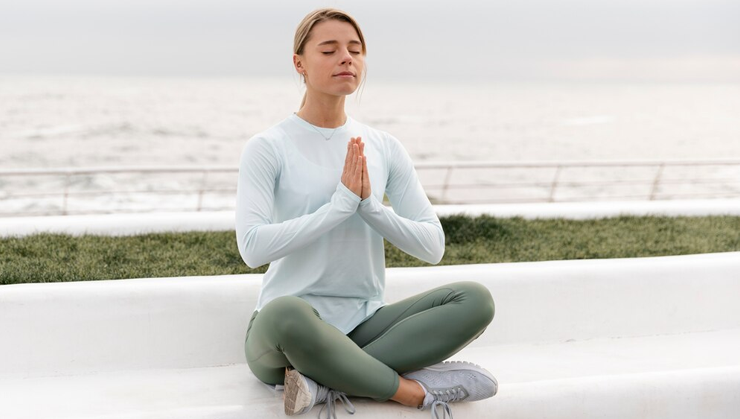+91 9891379934
For Call or WhatsApp

Pranayam or breathing exercise is a very important part of Yoga . Prana means life or vital force and Ayam means extension or dimension. So Pranayam is also called breath control. In Pranayam we breathe deep and long as much as possible to get maximum oxygen and pran urja or life energy for better health.
Breathe in and out as long and deep as possible.
You can do it with slow, medium or fast speed.
Precaution :
Old people or people with weak hearts or high blood pressure
should not breathe fast as it can increase blood pressure.
Benefits : lungs get lots of oxygen and Pran urja or energy for
better health
Exhale or breathe out with the abdomen moving in with every
exhalation.
You can do it with slow, medium or fast
speed.
Precaution : Old people or people with weak hearts
or high blood pressure should not breathe fast as it can
increase blood pressure.
Benefits : Good for digestion, kidneys , pancreas, liver,
intestine, metabolic system, constipation, diabetes,stone in
gall bladder, uterus , ovaries
Exhale or breathe out all air from lungs and hold the breath
(kumbhak) for a few seconds according to your comfort level.
When you feel it is too much to hold breath outside then slowly
inhale or breathe in.
Precaution : Old people or people
with weak hearts or high blood pressure should not hold their
breath (kumbhak ) for too long as it can increase blood
pressure. They should hold their breath ( kumbhak ) less or
according to their comfort level.
Benefits : Good for digestion, kidneys , pancreas, liver,
intestine, metabolic system, constipation, diabetes,stone in
gall bladder, uterus , ovaries
Exhale or breathe out all air from lungs and hold the breath (
kumbhak) for few seconds according to your comfort level along
with three locks ( bandhas)
Chin touching top of breastbone called Jalandhar bandh
Pull up the genitals called Mool Bandh
Pull the abdomen in and up towards the diaphragm called Uddiyan
Bandh.
When you feel it is too much to hold breath outside
then slowly inhale or breathe in and open all three locks or
bandhas.
Precaution : Old people or people with weak hearts
or high blood pressure should not hold their breath ( kumbhak )
for too long as it can increase blood pressure. They should hold
the breath ( kumbhak ) for less time or according to their
comfort level.
Benefits : Three bandhas or locks help to regulate the flow of
energy in the right direction. Due to Mool Bandh Kundalini
energy can not go down , it helps to raise the Kundalini energy
up towards the top of the head. Due to Kumbahak there is vacuum
which also helps to rise energy up because it is law of nature
where there is emptiness energy moves to that direction. Uddiyan
Bandh is good for abdomen and Jalandhar Bandh is good for
throat.
Inhale or breathe in with a tight throat making sound and hold
the breath ( kumbhak) for a few seconds according to your
comfort level along with two locks ( bandhas)
Chin touching top of breastbone called Jalandhar bandh
Pull up the genitals called Mool Bandh . When you feel it is too
much to hold breath inside then slowly exhale or breathe out and
open two locks or bandhas.
Precaution : Old people or
people with weak heart or high blood pressure should not hold
their breath ( kumbhak ) for too long as it can increase blood
pressure. They should hold their breath ( kumbhak ) for less
time or according to their comfort level.
Benefits : It is beneficial for Thyroid and Parathyroid glands .
People suffering from Thyroid problems get lots of benefits . It
is also beneficial for snoring or throat also .
Breathe in from the left nostril and breathe out from the right
nostril. Again inhale or breathe in from the right nostril and
breathe out or exhale from the left nostril.
Benefits : It
cures high or low blood pressure or heart problems. It balances
right and left hemisphere of brain as left nostril is related
with right hemisphere of brain and right nostril is related to
left hemisphere of brain. This pranayam also helps for going
deeper into meditation.
It comes from the word Bhramer which means honey bee because in
this pranayam we will hum OM with closed lips making the sound
like a honey bee .That is why it is called Bhramri.
Breathe in and fill your lungs with maximum air or pran
urja Close your eyes with two middle fingers and first two
fingers on forehead. Close ears with two thumbs and start huming
OM as long as possible.
Chant OM in a normal way.

Divya was born and brought up in Delhi, India and was practicing yoga from 30 years or more since childhood and his father was also teaching yoga. Divya was interested in spirituality from very early age.